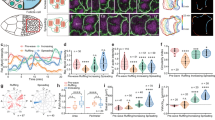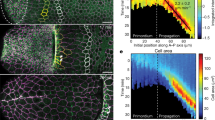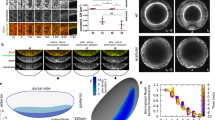Abstract
Apical constriction facilitates epithelial sheet bending and invagination during morphogenesis1,2. Apical constriction is conventionally thought to be driven by the continuous purse-string-like contraction of a circumferential actin and non-muscle myosin-II (myosin) belt underlying adherens junctions3,4,5,6,7. However, it is unclear whether other force-generating mechanisms can drive this process. Here we show, with the use of real-time imaging and quantitative image analysis of Drosophila gastrulation, that the apical constriction of ventral furrow cells is pulsed. Repeated constrictions, which are asynchronous between neighbouring cells, are interrupted by pauses in which the constricted state of the cell apex is maintained. In contrast to the purse-string model, constriction pulses are powered by actin–myosin network contractions that occur at the medial apical cortex and pull discrete adherens junction sites inwards. The transcription factors Twist and Snail differentially regulate pulsed constriction. Expression of snail initiates actin–myosin network contractions, whereas expression of twist stabilizes the constricted state of the cell apex. Our results suggest a new model for apical constriction in which a cortical actin–myosin cytoskeleton functions as a developmentally controlled subcellular ratchet to reduce apical area incrementally.
This is a preview of subscription content, access via your institution
Access options
Subscribe to this journal
Receive 51 print issues and online access
$199.00 per year
only $3.90 per issue
Buy this article
- Purchase on Springer Link
- Instant access to full article PDF
Prices may be subject to local taxes which are calculated during checkout




Similar content being viewed by others
References
Lecuit, T. & Lenne, P. F. Cell surface mechanics and the control of cell shape, tissue patterns and morphogenesis. Nature Rev. Mol. Cell Biol. 8, 633–644 (2007)
Leptin, M. Gastrulation movements: the logic and the nuts and bolts. Dev. Cell 8, 305–320 (2005)
Alberts, B. et al. Molecular Biology of the Cell 5th edn (Garland Science, 2008)
Baker, P. C. & Schroeder, T. E. Cytoplasmic filaments and morphogenetic movement in the amphibian neural tube. Dev. Biol. 15, 432–450 (1967)
Burnside, B. Microtubules and microfilaments in newt neuralation. Dev. Biol. 26, 416–441 (1971)
Hildebrand, J. D. Shroom regulates epithelial cell shape via the apical positioning of an actomyosin network. J. Cell Sci. 118, 5191–5203 (2005)
Karfunkel, P. The activity of microtubules and microfilaments in neurulation in the chick. J. Exp. Zool. 181, 289–301 (1972)
Dawes-Hoang, R. E. et al. folded gastrulation, cell shape change and the control of myosin localization. Development 132, 4165–4178 (2005)
Fox, D. T. & Peifer, M. Abelson kinase (Abl) and RhoGEF2 regulate actin organization during cell constriction in Drosophila . Development 134, 567–578 (2007)
Nikolaidou, K. K. & Barrett, K. A. Rho GTPase signaling pathway is used reiteratively in epithelial folding and potentially selects the outcome of Rho activation. Curr. Biol. 14, 1822–1826 (2004)
Young, P. E., Pesacreta, T. C. & Kiehart, D. P. Dynamic changes in the distribution of cytoplasmic myosin during Drosophila embryogenesis. Development 111, 1–14 (1991)
Morin, X., Daneman, R., Zavortink, M. & Chia, W. A protein trap strategy to detect GFP-tagged proteins expressed from their endogenous loci in Drosophila . Proc. Natl Acad. Sci. USA 98, 15050–15055 (2001)
Oda, H. & Tsukita, S. Real-time imaging of cell–cell adherens junctions reveals that Drosophila mesoderm invagination begins with two phases of apical constriction of cells. J. Cell Sci. 114, 493–501 (2001)
Sweeton, D., Parks, S., Costa, M. & Wieschaus, E. Gastrulation in Drosophila: the formation of the ventral furrow and posterior midgut invaginations. Development 112, 775–789 (1991)
Vavylonis, D., Wu, J. Q., Hao, S., O’Shaughnessy, B. & Pollard, T. D. Assembly mechanism of the contractile ring for cytokinesis by fission yeast. Science 319, 97–100 (2008)
Verkhovsky, A. B., Svitkina, T. M. & Borisy, G. G. Myosin II filament assemblies in the active lamella of fibroblasts: their morphogenesis and role in the formation of actin filament bundles. J. Cell Biol. 131, 989–1002 (1995)
Svitkina, T. M., Verkhovsky, A. B., McQuade, K. M. & Borisy, G. G. Analysis of the actin–myosin II system in fish epidermal keratocytes: mechanism of cell body translocation. J. Cell Biol. 139, 397–415 (1997)
Muller, H. A. & Wieschaus, E. armadillo, bazooka, and stardust are critical for early stages in formation of the zonula adherens and maintenance of the polarized blastoderm epithelium in Drosophila . J. Cell Biol. 134, 149–163 (1996)
Kolsch, V., Seher, T., Fernandez-Ballester, G. J., Serrano, L. & Leptin, M. Control of Drosophila gastrulation by apical localization of adherens junctions and RhoGEF2. Science 315, 384–386 (2007)
Ip, Y. T., Maggert, K. & Levine, M. Uncoupling gastrulation and mesoderm differentiation in the Drosophila embryo. EMBO J. 13, 5826–5834 (1994)
Leptin, M. twist and snail as positive and negative regulators during Drosophila mesoderm development. Genes Dev. 5, 1568–1576 (1991)
Leptin, M. & Grunewald, B. Cell shape changes during gastrulation in Drosophila . Development 110, 73–84 (1990)
Seher, T. C., Narasimha, M., Vogelsang, E. & Leptin, M. Analysis and reconstitution of the genetic cascade controlling early mesoderm morphogenesis in the Drosophila embryo. Mech. Dev. 124, 167–179 (2007)
Costa, M., Wilson, E. T. & Wieschaus, E. A putative cell signal encoded by the folded gastrulation gene coordinates cell shape changes during Drosophila gastrulation. Cell 76, 1075–1089 (1994)
Keller, R., Shook, D. & Skoglund, P. The forces that shape embryos: physical aspects of convergent extension by cell intercalation. Phys. Biol. 5, 15007 (2008)
Royou, A., Sullivan, W. & Karess, R. Cortical recruitment of nonmuscle myosin II in early syncytial Drosophila embryos: its role in nuclear axial expansion and its regulation by Cdc2 activity. J. Cell Biol. 158, 127–137 (2002)
Franke, J. D., Montague, R. A. & Kiehart, D. P. Nonmuscle myosin II generates forces that transmit tension and drive contraction in multiple tissues during dorsal closure. Curr. Biol. 15, 2208–2221 (2005)
Edwards, K. A., Demsky, M., Montague, R. A., Weymouth, N. & Kiehart, D. P. GFP–moesin illuminates actin cytoskeleton dynamics in living tissue and demonstrates cell shape changes during morphogenesis in Drosophila . Dev. Biol. 191, 103–117 (1997)
Arziman, Z., Horn, T. & Boutros, M. E-RNAi: a web application to design optimized RNAi constructs. Nucleic Acids Res. 33, W582–W588 (2005)
Acknowledgements
We thank D. Kiehart and R. Karess for providing flies; J. Goodhouse for assisting with microscopy; and S. De Renzis, X. Lu, T. Schupbach, A. Sokac, F. Ulrich and Y.-C. Wang for helpful comments on the manuscript. This work is supported by grant PF-06-143-01-DDC from the American Cancer Society to A.C.M., National Institutes of Health/National Institute of General Medical Sciences grant P50 GM071508 to M.K., and by National Institute of Child Health and Human Development grant 5R37HD15587 to E.F.W. E.F.W. is an investigator of the Howard Hughes Medical Institute.
Author Contributions Biological reagents and fly stocks were made by A.C.M. and E.F.W., and experiments were performed by A.C.M. Image analysis methods were developed by M.K. and the live-imaging data were analysed by A.C.M. and M.K. The first draft of the manuscript was written by A.C.M. All authors participated in discussion of the data and in producing the final version of the manuscript.
Author information
Authors and Affiliations
Corresponding author
Supplementary information
Supplementary Figures
This file contains Supplementary Figures S1- S4 with Legends (PDF 3390 kb)
Supplementary Video 1
Supplementary Video 1 shows a ventral furrow apical constriction visualized with Spider-GFP. The focal plane was adjusted to stay 2 µm below the apical surface along the ventral midline. Time interval between acquired frames was 6 s and the acquisition length was 8 minutes. Video is 36x faster than real-time. (MOV 7419 kb)
Supplementary Video 2
Supplementary Video 2 shows a pulsed constriction of ventral furrow cells. Cell outlines are labelled with Spider-GFP. Time interval between acquired frames was 6 s and the acquisition length was 5 minutes. Video is 72x faster than real-time. (MOV 354 kb)
Supplementary Video 3
Supplementary Video 3 shows that the pulsed constriction is asynchronous. The colour of the cell indicates the constriction rate (as illustrated by the colour bar in Fig. 1h) for a given time point. Time interval between acquired frames was 6s and the acquisition length was 6 minutes. Video is 18x faster than real-time. (MOV 2533 kb)
Supplementary Video 4
Supplementary Video 4 shows apical myosin dynamics during ventral furrow cell apical constriction. Z-projections of Myosin-mCherry (green, 5 µm depth) are merged with a single Spider-GFP z-slice located 2 µm below the apical cortex (red). Time interval between acquired frames was 5 s and the acquisition length was 7.5 minutes. Video is 25x faster than real-time. (MOV 11170 kb)
Supplementary Video 5
Supplementary Video 5 shows that myosin coalescence accompanies apical constriction. Z-projections of Myosin-mCherry (green, 5 µm depth) are merged with a single Spider-GFP z-slice located 2 µm below the apical cortex (red and bottom). Time interval between acquired frames was 6 s and the acquisition length was 2.6 minutes. Video is 50x faster than real-time. (MOV 770 kb)
Supplementary Video 6
Supplementary Video 6 shows that .Twist and Snail differentially regulate myosin dynamics. Z-projections of Myosin-GFP (5 µm depth) for the indicated genetic backgrounds. Note that myosin coalescence is more prominent in twist mutant embryos than snail mutant embryos. This results in more movement of myosin structures since they are being pulled. Time interval between acquired frames was 10 s and the acquisition length was 16.7 minutes. Video is 100x faster than real-time. (MOV 18122 kb)
Supplementary Video 7
Supplementary Video 7 shows that. twistRNAi and snailRNAi mimic the mutant phenotypes. Z-projections of Myosin-GFP for the indicated knock-downs. Time interval between acquired frames was 10 s and the acquisition length was 16.7 minutes. Video is 100x faster than real-time. Note that the phenotypes are not as severe as the null mutants, probably due to remaining Twist and Snail activity. (MOV 10269 kb)
Supplementary Video 8
Supplementary Video 8 shows that the Constriction pulses in twistRNAi embryos are not stabilized. Cell outlines 2 µm below the apical cortex are labelled using SpiderGFP. Cell shape is relatively constant in snailRNAi embryos, while fluctuations in cell size and shape occur in twistRNAi embryos. Time interval between acquired frames was 6 s and the acquisition length was 7 minutes. Video is 36x faster than real-time. (MOV 10159 kb)
Rights and permissions
About this article
Cite this article
Martin, A., Kaschube, M. & Wieschaus, E. Pulsed contractions of an actin–myosin network drive apical constriction. Nature 457, 495–499 (2009). https://doi.org/10.1038/nature07522
Received:
Accepted:
Published:
Issue Date:
DOI: https://doi.org/10.1038/nature07522
This article is cited by
-
Size-dependent transition from steady contraction to waves in actomyosin networks with turnover
Nature Physics (2024)
-
How multiscale curvature couples forces to cellular functions
Nature Reviews Physics (2024)
-
The Critical Role of the Shroom Family Proteins in Morphogenesis, Organogenesis and Disease
Phenomics (2024)
-
Homeotic compartment curvature and tension control spatiotemporal folding dynamics
Nature Communications (2023)
-
Biomechanical, biophysical and biochemical modulators of cytoskeletal remodelling and emergent stem cell lineage commitment
Communications Biology (2023)
Comments
By submitting a comment you agree to abide by our Terms and Community Guidelines. If you find something abusive or that does not comply with our terms or guidelines please flag it as inappropriate.



